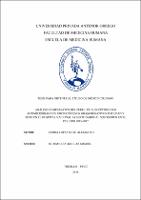Mostrar el registro sencillo del ítem
Análisis comparativo del perfil de susceptibilidad antimicrobiana de uropatógenos gram-negativos por edad y sexo en el Hospital Nacional Alberto Sabogal Sologuren en el periodo 2015 - 2017
| dc.contributor.advisor | Ramirez Aguilar, Miguel | |
| dc.contributor.author | Cerna Lopez, Julio Alejandro | |
| dc.creator | Cerna Lopez, Julio Alejandro | |
| dc.date.accessioned | 2018-04-12T21:40:51Z | |
| dc.date.available | 2018-04-12T21:40:51Z | |
| dc.date.issued | 2018 | |
| dc.identifier.uri | https://hdl.handle.net/20.500.12759/3978 | |
| dc.description.abstract | En un mundo donde existe una variedad de medicamentos utilizados para tratar una gran diversidad de enfermedades; hay un grupo muy especial, los cuales nos ayudan combatir aquellas patologías causadas por bacterias —ya sean Gram-positivas o negativas— recibiendo el nombre de antibacterianos o antibióticos. Estos poco a poco están perdiendo su eficacia a través de mecanismos bacterianos que disminuyen su susceptibilidad a distintos microorganismos, lo cual puede estar influenciado por distintos factores. Así el objetivo de este estudio es comparar el perfil de susceptibilidad antimicrobiana de uropatógenos Gramnegativos por edad y sexo en el Hospital Nacional Alberto Sabogal Sologuren en el periodo 2015 – 2017. Para esto se realizó un estudio de serie de casos, evaluándose 6584 urocultivos de pacientes con atención en consultorio externo, determinándose los uropatógenos Gramnegativos más frecuentes y la susceptibilidad antimicrobiana según año, sexo y edad (<65 años y ≥65 años). El estudio mostró que el 71% de los aislados fue E. coli, seguido en una menor proporción por Klebsiella pneumoniae (11.3%), Pseudomonas aeruginosa (4.3%), Proteus mirabilis (3.3%) y otros Gram-negativos (10.1%). Los cuales, excepto P. aeruginosa, mostraron una susceptibilidad mayor del 90% para amikacina (93-99%), gentamicina (75-83%), ceftazidima (94-100%), ceftriaxona (96-99%), ertapenem (100%), piperacilina/tazobactam (88-100%) y tigeciclina (96-100%), en cambio levofloxacino fue menor del 80% (23-80%), sin variación significativa (p>0.05) relacionado a cada año; P. aeruginosa mostró una susceptibilidad disminuida para piperacilina/tazobactam (70-79%), siendo menor del 50% para el resto de antibióticos. Además, se observó que el género femenino presenta una mayor susceptibilidad con gentamicina (Δ=10-20%, p<0.05) para E. coli y K. pneumoniae y con ceftazidima (Δ=28%, p<0.05) para P. aeruginosa; pero con el resto de antibióticos no hubo diferencia (p>0.05). Del mismo modo, en personas menores de 65 años la gentamicina tuvo mejor susceptibilidad (Δ=6-20%, p<0.05), sin diferencia significativa (p>0.05) con el resto de antibióticos. Se establece que E. coli es el uropatógeno más frecuente, la susceptibilidad en el periodo de 3 años no ha variado significativamente y que el sexo femenino y el grupo etario menor de 65 años presentan mejor perfil de susceptibilidad antibiótica. | es_PE |
| dc.description.abstract | In a world where there is a variety of drugs used to treat a wide variety of diseases; there is a very special group, which helps us to fight those pathologies caused by bacteria -whether they are Gram-positive or negative- receiving the name of antibacterials or antibiotics. These are little by little losing their effectiveness through bacterial mechanisms that reduce their susceptibility to different microorganisms, which may be influenced by different factors. Thus the objective of this study is to compare the profile of antimicrobial susceptibility of Gram-negative uropathogens by age and sex in the National Hospital Alberto Sabogal Sologuren in the period 2015 - 2017. For this case series study was carried out, evaluating 6584 urocultures of patients with outpatient care, determining the most frequent Gramnegative uropathogens and antimicrobial susceptibility according to year, sex and age (<65 years and ≥65 years). 71% of the isolates were E. coli, followed in a smaller proportion by Klebsiella pneumoniae (11.3%), Pseudomonas aeruginosa (4.3%), Proteus mirabilis (3.3%) and other Gramnegative (10.1%). Which, except P. aeruginosa, showed a greater susceptibility of 90% for amikacin (93-99%), gentamicin (75-83%), ceftazidime (94-100%), ceftriaxone (96-99%), ertapenem (100%), piperacillin / tazobactam (88-100%) and tigecycline (96-100%), while levofloxacin was less than 80% (23-80%), without significant variation (p> 0.05) related to each year; P. aeruginosa showed a decreased susceptibility to piperacillin/tazobactam (7079%), being less than 50% for the rest of antibiotics. In addition, it was observed that the female gender has a greater susceptibilit y to gentamicin (Δ = 10-20%, p <0.05) for E. coli and K. pneumoniae and with ceftazidime (Δ = 28%, p <0.05) for P. aeruginosa; but with the rest of antibiotics there was no difference (p> 0.05). Similarly, in people under 65 gentamicin had better susceptibilit y (Δ = 6-20%, p> 0.05), without significant difference (p> 0.05) with the rest of antibiotics. It is established that E. coli is the most frequent uropathogen, susceptibility in the period of 3 years has not changed significantly and that the female sex and the age group younger than 65 have a better profile of antibiotic susceptibility. | en_US |
| dc.description.uri | Tesis | es_PE |
| dc.format | application/pdf | es_PE |
| dc.language.iso | spa | es_PE |
| dc.publisher | Universidad Privada Antenor Orrego - UPAO | es_PE |
| dc.relation.ispartofseries | T_MED.HUMA_2359 | |
| dc.rights | info:eu-repo/semantics/openAccess | es_PE |
| dc.source | Universidad Privada Antenor Orrego | es_PE |
| dc.source | Repositorio Institucional - UPAO | es_PE |
| dc.subject | Gran negativos | es_PE |
| dc.subject | Urocultivo | es_PE |
| dc.title | Análisis comparativo del perfil de susceptibilidad antimicrobiana de uropatógenos gram-negativos por edad y sexo en el Hospital Nacional Alberto Sabogal Sologuren en el periodo 2015 - 2017 | es_PE |
| dc.type | info:eu-repo/semantics/bachelorThesis | es_PE |
| thesis.degree.level | Título Profesional | es_PE |
| thesis.degree.grantor | Universidad Privada Antenor Orrego. Facultad de Medicina Humana | es_PE |
| thesis.degree.name | Médico Cirujano | es_PE |
| thesis.degree.discipline | Medicina Humana | es_PE |
Ficheros en el ítem
Este ítem aparece en la(s) siguiente(s) colección(es)
-
Medicina Humana [2749]

